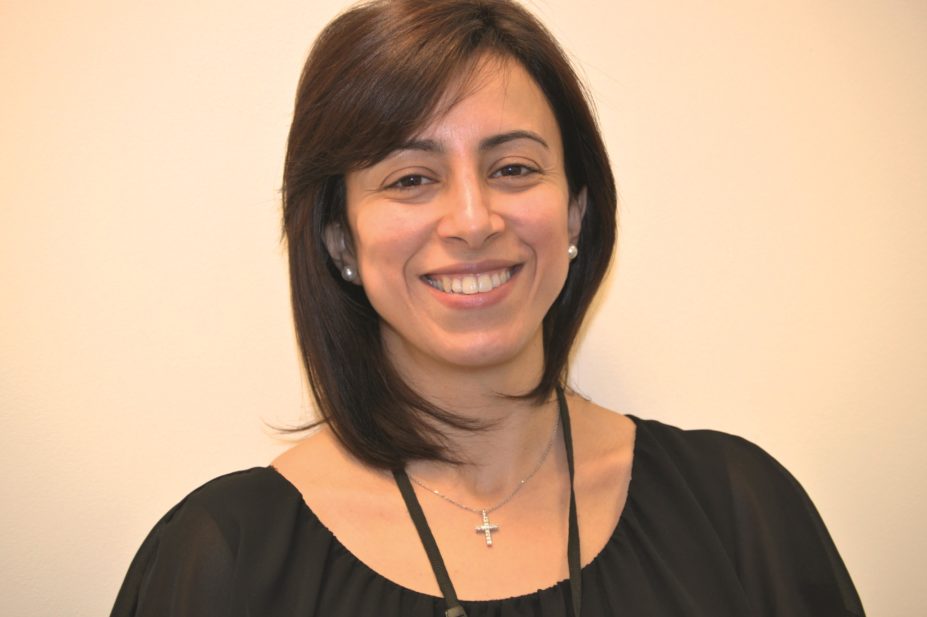
Courtesy of Amira Guirguis
Why did you decide to do a PhD?
As a pharmacy undergraduate and pre-registration trainee, I was always excited by the prospect of research. I was involved in various research projects about a variety of topics including the transdermal delivery of diclofenac diethylamine, with MedPharm, and metal complexity in herbal medicines at the University of Hertfordshire.
When I qualified, I decided to pursue research and applied for a PhD post at the University of Hertfordshire on new psychoactive substances (NPSs) of misuse — so-called “designer drugs”. At the time, I was working as a hospital pharmacist and it was not uncommon to encounter patients admitted with an unknown source of poisoning. Information available to healthcare professionals on current patterns of NPS misuse is lacking. Accepting this PhD post has inspired me to help make a difference at both clinical and regulatory levels.
What problem does your research address?
My PhD involves designing a model for improving the on-site identification of NPSs by frontline staff, including border officers, forensic teams and emergency staff.
NPSs are “home-made” analogues of traditional drugs of misuse, such as cocaine and heroin, which mimic their effect. For example, cathinones such as mephedrone, methylone and MDPV (3,4-methylenedioxypyrovalerone) exhibit amphetamine-, ecstasy- and cocaine-like profiles, respectively. Despite sharing the cathinones’ backbone, they have been shown to act preferentially and differently on dopamine, serotonin and noradrenaline pathways[1]
.
Unlike pharmaceuticals, these substances are not tested or regulated. They are initially legal before being banned by individual countries. In the UK, cathinones were classified as controlled drugs under Schedule II of the Misuse of Drugs Act 1971 in 2010 through a generic definition — banning all substances that include a slight structural modification to the generic chemical structure of cathinone[2]
. In contrast, individual cathinones were placed under temporary orders in the United States, where the cathinone 4-MEC (4-methylethcathinone) was only classified as a schedule I controlled drug in 2014[3]
. The content of NPSs is continually changing over time to circumvent the law and to hinder their identification.
The number of available NPSs is estimated to have more than doubled from 2009 to 2013. In 2013, approximately two new NPSs were notified to the European Early Warning System every week across 30 European countries[4]
. The total number of NPSs formally notified to the United Nations Office on Drugs and Crimes was 445 substances by December 2013[5]
(see ‘A growing problem’ [1]
).
Why is your research important?
The increased availability, number and diversity of NPSs are posing serious public health concerns.
NPSs have been shown to be covertly cut with harmful active diluents, which may lead to inadvertent intoxications. The wide range of NPS potencies have been linked to accidental overdoses. Knowledge regarding fatal intoxications where NPSs were involved is limited and current trends of NPS misuse and the combined effects of ingested or injected mixtures are not fully understood. Detecting that a patient has NPS poisoning and identifying the class and quantity of NPSs consumed are key to finding antidotes and supportive adjunct treatments to prevent avoidable deaths[6]
.
What does your work involve?
I am carrying out my research on both street and pure samples and I am continually being updated about information on seizures and toxicities (including fatalities) from various forensic reports.
Part of my work is to attend conferences and disseminate my research findings. Recently, the research I contribute to has been recognised with two awards: ‘The 2014 Geoffrey Phillips analytical science award’, provided by the Joint Pharmaceutical Analysis Group (JPAG), and a joint ‘Research, evaluation and audits award’ from the Royal Pharmaceutical Society (RPS). These awards represent an acknowledgement of what I have achieved and recognition of the potential impact this research may have, including reducing hospital admissions and saving lives.
I also work part-time during evenings and weekends as a pre-registration trainer, RPS mentor, visiting lecturer at University of Hertfordshire, and research and projects lead of the London North West local practice forum. I am also collaborating with researchers across Europe to support an EU Commission grant recently awarded to the University of Hertfordshire (EU MADNESS). This was awarded as part of a Europe-wide project to monitor, analyse and disseminate information about NPSs to update healthcare professionals and reduce harms to public health.
Where would you like your research to take you?
My short-term aim is to collaborate with other healthcare professionals to disseminate knowledge and awareness of continually emerging NPSs. I believe we can reduce the gap between research and practice by creating a system that collects data about NPSs and symptoms of toxicity from emergency settings. It would also be helpful if pharmacists who encounter new NPSs in their practice could anonymously report these to local focal points, which, in turn, would report them to the Home Office.
My ultimate goal is to obtain an academic position and conduct my own original, innovative research. I wish to hold a post-doctoral fellow or a lecturer post. In addition, I would like to continue supporting pre-registration trainees.
References
[1] Iversen L, White M & Treble R. Designer psychostimulants: Pharmacology and differences. Neuropharmacology 2014;87C:59–65.
[2] Home Office. A change to the Misuse Of Drugs Act 1971: Control of mephedrone and other cathinone derivatives. Home Office circular 010/2010.
[3] Drug Enforcement Administration, Department of Justice. Schedules of Controlled Substances: Temporary Placement of 10 synthetic cathinones into Schedule I. 21 CFR Part 1308. 2014.
[4] Levissianos S. The UNODC Early Warning Advisory (EWA) on New Psychoactive Substances (NPS) – New trends in novel psychoactive substances, 2014. Rome: United Nation on Drugs and Crimes.
[5] United Nations Office on Drugs and Crimes (UNODC), World drug report. United Nations: Vienna, 2014.


